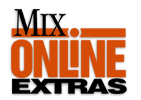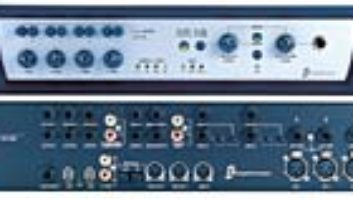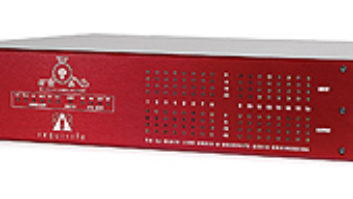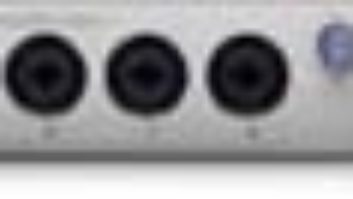
The Digi 002 is a native 32-track software/hardware system forWindows and Mac that falls right in the middle of Digidesign’sDAW lineup. It includes Digidesign’s well-known Pro Tools LE anda healthy collection of bundled RTAS-format plug-ins from Digidesignand third-party developers. The hardware unit has a look that’svaguely reminiscent of ’50s sci-fi tech, and contains the audiointerface, an outstanding motorized touch-sensitive control surface anda 1×2 MIDI interface; all information gets carried down a singleFireWire cable to/from the host computer.
The 002 operates at resolutions up to 24-bit/96 kHz, and it haseight analog ins (four with mic preamps), an 8-channel ADAT Lightpipeport (switchable to optical S/PDIF) and RCA S/PDIF digital I/O. It alsohas six analog outs and stereo main outputs with parallel monitor outs.Just hook up an amp/speakers for a fully self-contained productionrig.
Digidesign refers to the 002 as a “Pro Tools workstation,”because Pro Tools LE session files are 100% compatible with other ProTools system. The only considerations are that Pro Tools LE just opensthe first 32 tracks and the only other Pro Tools system that supports96 kHz is Pro Tools|HD, which also supports 192 kHz. Pro Tools LE willeven attempt to open RTAS host-based versions of hardware TDM plug-insfrom sessions created in Pro Tools MIX or HD systems.
The 002 can operate as a stand-alone 8×4 mini-digital mixer withsnapshots and built-in EQ, dynamics and reverb. Its DSP andconverter-latency-only monitoring are commandeered for the 002’sregular activities when you’re using the mixer in Pro Tools mode(i.e., with a computer), but you regain the use of the Lightpipe andS/PDIF ports, bringing the potential number of simultaneous computerins and outs to 18.
Hardware Details
In addition to the I/O listed above, the 002 has a stereo pair of-10dBV RCA outputs that parallel the main outs. There’s also apair of RCA ins that can be switched to function like 2-track monitorreturns or to step in for the 1/4-inch jacks feeding analog ins 7 and8.
Deluxe inputs 1 through 4 are the mic/line channels; their sources canbe toggled on the panel between XLR mic and 1/4-inch TRSline/instrument inputs. These channels also have gain knobs, rumblefilters and 48-volt phantom power that can be turned on in pairs.
The remaining line inputs 5 through 8 have switches to select -10dBVor +4dBu operation. The 002’s analog I/O is electronicallybalanced, and the ins/outs are happy with either kind of signal orload.
Other notables: The main outs list marginally better specs than themonitor outs (112dB dynamic range rather than 110dB); Mute and Monoswitches are provided for the monitor out; there’s a built-inheadphone jack with its own level control; and you can punch in and outwhen recording audio or MIDI using a footswitch. To my ears, the 002sounds clean and crisp, easily meeting my expectations in comparison toother mid-price project studio units. Someone recording a major-labelrelease could use outboard high-end mic preamps and converters, butwhat goes in is pretty much what comes out.
Pro Tools LE
Pro Tools has gained widespread professional acceptance as an audioproduction system; it’s now familiar enough that we won’tcover it in great detail. In fact, you can download Pro Tools Free, afunctional 8-track Windows/Mac version from www.digidesign.comat no cost and check it out up close.
In addition to the 32 audio tracks (plus unlimited“takes”), the Pro Tools LE Version 5.2.2 included with the002 features 128 MIDI tracks that run side-by-side with the audio.Subjectively, Pro Tools is an outstanding production program and, forthose of us using MIDI, a passable composition program—unless youdon’t rely on quick and extensive editing or integrated notationand other now-standard MIDI sequencer features. Pro Tools does do avery good job with MIDI timing, though, and many users import MIDIfiles into Pro Tools at the last stage to use the program for its audioproduction features.
For those people, there’s a Windows 002 ASIO driver so thatyou can use the unit as an audio interface (but not a control surface)for the software of your choice. Digidesign says that it’sworking on a CoreAudio OS X driver for Mac, but there’s no OS 9ASIO or Direct I/O driver.
Probably the most ballyhooed difference between the full and LEversions of Pro Tools is that there’s no timecode ruler in LE.Contrary to popular opinion, you actually can still lock Pro Tools LEto timecode. The program supports MTC trigger sync; while the 002hardware doesn’t have a wordclock input, it can clock to a“digital black” signal at its S/PDIF digital input. A goodoutboard synchronizer will let the 002 get its address location fromMTC and its clock from the synchronizer.
One surprise we discovered in the heat of battle, however, is thatthe 002 will only lock to “consumer” RCA S/PDIF; itdoesn’t use the hybrid AES/S/PDIF format, and it won’t workwith an XLR-to-RCA adapter on an AES/EBU line.
This version of Pro Tools LE is quite solid. I did encounter acouple of unrepeatable anomalies (such as tracks’ input selectoroffering optical S/PDIF as a choice when the system was set to RCAS/PDIF input), but nothing that stopped the show or that didn’tgo away after a restart.
The 002 comes with a complete collection of RTAS format plug-ins.Most of these are Digidesign’s, covering the gamut of frequency-and time-based effects and processes: EQ, reverb, time stretching,delay, dynamics, a signal generator, audio manglers and more.
Three processors from Waves’ Renaissance collection are alsopart of the bundle. One is the Renaissance Reverb, which is decent ashost-based reverbs go—faint praise, but praise nonetheless. Theother two from Waves are as good as any plug-in available: theRenaissance EQ and Renaissance Compressor, making this a pretty majorpot-sweetener.
The unit we received also had a version of IK Multimedia’sSampleTank sample preset player and AmpliTube guitar amp modeler.SampleTank has some really nice sounds, and AmpliTube happens to workvery well on drums. Native Instruments’ Pro-52, an impressivere-creation of the classic Sequential Circuits’ Prophet 52 analogsynth, was also included. These plug-ins may or may not be bundled bythe time you read this review.
Note that plug-ins must be adapted to work on the 002, if for noother reason than to support the higher sampling rates.
System Requirements
Digidesign publishes very specific details about the computers andperipherals it certifies to work at the specified performance levelwith its systems. Windows systems require Windows XP, and it suggests a2.0-plus-GHz Intel Pentium 4 or AMD AthlonXP 2000+ processor for bestresults.
Mac systems require an “Ice White” iBook (G3/500) or2000 Powerbook “Pismo” G3/400 or better, with a G4 stronglyrecommended. Most of the time, we ran the 002 on a“Quicksilver” dual-1GB Mac, and that machine did great.
However, the G4/500-upgraded Pismo we tried—an admittedlyunapproved device, but one that should meet spec—was anotherstory. The FireWire implementation on some earlier FireWire Macs istenuous, and the 002 has a lot of FireWire activity going on, between36 open audio channels (18 in either direction), MIDI and its controlsurface.
With a freshly defragmented FireWire disk, this machine huffs andpuffs its way to delivering 32-track simultaneous recording/playback at24 bits, 44.1 or 48 kHz; 24 tracks is more realistic, and even then,you can’t loop heavily edited passages. At 88.1 or 96 kHz, thatnumber goes way down, and once you get the “disk too slow orfragmented” message, the system digs its heels in.
Digidesign means it when it advises you against using the internaldrive for recording. It’s only possible to record a couple oftracks onto the Pismo’s slow internal drive. I was hoping to usethe 002 to record impulse responses of Los Angeles’ Zipper Hallfor Audio Ease’s Altiverb—which, incidentally, is one ofthe plug-ins that works on the 002—but it dug its heels in, andwe had to use a backup device (which worked fine).
Did the G4 upgrade interfere with the Pismo’s FireWireperformance? It seems unlikely, yet Digidesign has tested the 002 withPismo Powerbooks and found it worked. In any case, if you have a fastIntel Pentium 4 or AMD Athlon machine, or a recent G4 Powerbook ordesktop computer, you should be delighted with system performance.
Control Surface
Digidesign’s engineers obviously put a lot of thought into the002’s approximately 19×17-inch (WxD) control surface. It providesfar more useful control than other surfaces with a lot more buttons,knobs and display real estate. Rather than wasting the available partscount on things that are much easier on the computer (such as choosingand inserting plug-ins), the designers chose to include just what youneed from a surface and nothing more.
Buttons to call up the main screens are there; there aren’tany convoluted buttons to assign tracks to outputs. A button to scrollto the master fader is great. And what you want to see is big and bold.For example, the navigation arrows, which, among other things, scrollup and down banks of eight faders, are big and easy to spot on a raisedsurface that’s positioned exactly where your right hand wants tofind them. Meanwhile, the modifier keys are on their own where yourleft hand wants them to be and your eyes locate them.
Digidesign gets maximum mileage out of the eight touch-sensitivemotorized faders—which have a decent, if somewhat lightfeel—and velocity-sensitive rotary knobs. Touch a fader, and thedisplay in its LED changes from the track’s name (“scribblestrip”) to the level (-10.2 dB, etc.); about half a second afteryou’ve stopped touching it, the display reverts back to the trackname. Flip mode, which on most consoles assigns send levels to thefaders and channel levels to the knobs, is nothing new. But the 002goes further. Not only can you assign plug-in parameters to the rotaryknobs, but you can also assign them to the faders themselves.
The same efficiency is found in the use of the 10 four-digit LEDdisplays, and especially in the 15-light rings around each rotary knob.These rings are cleverly positioned where the surface slopes up and theknobs don’t obscure them. They serve to show the pots’positions, and then their lights become channel-level meters.
My only comment applies to all touch-sensitive faders of this ilk:You have to touch the top of a fader for it to sense your touch andrelease its “clutch”: If you want to nudge a fader up fromits front edge with your finger resting on the mixer surface, thefaders fight you; response over FireWire is very fast.
Thus
Retailing at $2,495, the 002 is a well-designed DAW that handily fitsa number of applications. For example, it’s a nice littlestudio-in-a-box a la weekend warrior’s live mixer; it makes anexcellent auxiliary Pro Tools system for someone to work on sessionsthat start and/or end in a TDM Pro Tools rig; it’s a greatportable rig; and it’s the heart of a small professional systemthat sounds as good as the outboard equipment that you use with it.
With the Digi 002’s wonderful control surface, nice audiointerface and solid Pro Tools software, this one’s a thumbsup!
Digidesign, 2001 Junipero Serra Blvd., Daly City, CA 94014;800/333-2137; www.digidesign.com.
Nick Batzdorf was the editor of Recording for more than 10years.
Front view of the Digi 002
Top view of the Digi 002
Want more? Take an in-depth Quicktime tour ofthe Digi 002.





